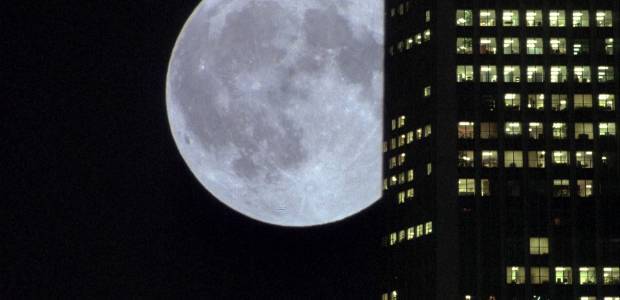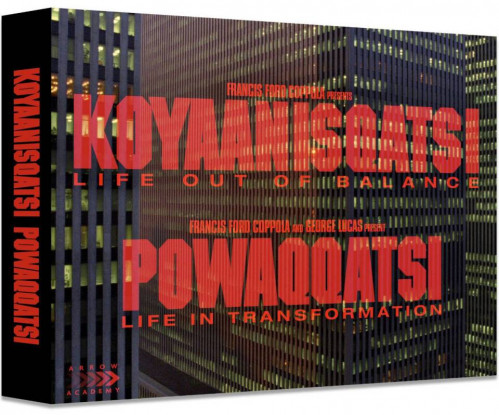IMAX: 'KOYAANISQATSI' + 'POWAQQATSI' [1982 / 1988 / 2014] [Blu-ray] [UK Release] A Visual Concert of Images set to the Haunting Music of Phillip Glass! An Exquisite Combination of Sound and Vision!
Told without dialogue, narration, cast or characters, ‘KOYAANISQATSI’ [Life Out Of Balance] and ‘POWAQQATSU’ [Life In Transformation] are dizzying, hypnotic examples of cinema set to extraordinary scores by Philip Glass. The first instalment concentrates on the United States, contrasting its natural beauty with a population ever more dependent on modern technology. The second switches to the Southern hemisphere and focuses on cultures and traditions that are slowly eroding away as the modern world takes over.
KO – YAA – NIS – QATSI [from the Hopi language] Crazy Life. Life in Turmoil. Life Out of Balance. Life Disintegrating. A State of Life that calls for another way of living.
PO – WAQ – QA – TSU [from the Hopi language] An entity, a way of life, that consumes the life forces of other beings in order to further its own life.
KOYAANISQATSI FILM FACT: Awards and Nominations: 1983 Berlin International Film Festival: Nominated: Golden Berlin Bear for Godfrey Reggio. 1983 Kansas City Film Critics Circle Awards: Win: Best Documentary. 1983 Los Angeles Film Critics Association Awards: Win: Best Music for Philip Glass. 1984 São Paulo International Film Festival: Win: Audience Award for Best Feature for Godfrey Reggio. 1988 Warsaw International Film Festival: Win: Audience Award for Godfrey Reggio. 2000 National Film Preservation Board, USA: Win: National Film Registry.
KOYAANISQATSI Cast: Lou Dobbs (archive footage) (uncredited) and Ted Koppel (archive footage) (uncredited)
POWAQQATSI Cast: Christie Brinkley (archive footage), David Brinkley (archive footage), Pope John Paul II (archive footage), Dan Rather (archive footage) and Cheryl Tiegs (archive footage)
Director: Godfrey Reggio
KOYAANISQATSI Producer: Godfrey Reggio
POWAQQATSI Producers: Francis Ford Coppola, George Lucas, Godfrey Reggio, Lawrence Taub, Marcel Kahn, Mandeep Kakkar, Mel Lawrence, Menahem Golan, Shyam Benegal, Tom Garrett, Tom Luddy and Yoram Globus
KOYAANISQATSI Screenplay: Alton Walpole, Godfrey Reggio, Michael Hoenig and Ron Fricke
POWAQQATSI Screenplay: Godfrey Reggio and Ken Richards
Composer: Philip Glass
KOYAANISQATSI Cinematography: Ron Fricke (Director of Photography)
POWAQQATSI Cinematography: Graham Berry (Director of Photography) and Leonidas Zourdoumis (Director of Photography)
Image Resolution: 1080p
Aspect Ratio: 1.85:1
Audio: 5.1 DTS-HD Master Audio
English: 2.0 LPCM Stereo Audio
Subtitles: None
Running Time: 86 minutes and 99 minutes
Region: Region B/2
Number of discs: 2
Studio: Arrow Academy
Andrew’s Blu-ray Review: IMAX: 'KOYAANISQATSI' + 'POWAQQATSU' films give us “The power of art is its mystery and the meaning is in the eye of the beholder. So when I make a film I think of it as a "trilectic" relationship of image, music, and the viewer. If there are a hundred people that see this film in a theatre at any given time, then there could be a hundred different points of view about it.” Says Director Godfrey Reggio.
Arrow Academy has released Godfrey Reggio’s first two classic films ‘KOYAANISQATSI’ which is a Francis Ford Coppola presentation + ‘POWAQQATSI’ is also a Francis Ford Coppola and George Lucas presentation together on this 2 Blu-ray discs for the first time. Here we have stunning gorgeous looking films such as these could well be what the Blu-ray format was invented for. In characteristic Arrow Academy style, the release comes with a wealth of brilliant extra special features. These include: a whopping stunning 72-page booklet, featuring a number of essays and a collection of contemporary reviews, as well as filmed interviews with Godfrey Reggio and composer Philip Glass, and the director’s 1992 short ‘Anima Mundi.’ All this is very much welcome as neither film contains a single word of dialogue and you could quite easily end up wondering what they are all about.
Both films have been given names in the language of the Hopi people of the South-western United States. Qatsi means life, and Koyaanis means craziness or turmoil, while powaq means sorcerer. So, ‘KOYAANISQATSI’ translates as a life out of balance and ‘POWAQQATSI’ means life in transformation, which is also the subtitle of each film and the first film ‘KOYAANISQATSI’ came out in 1982 and looks at America. ‘POWAQQATSI’ came out in 1988 and focuses on the developing world.
Both films present an extended montage of the natural and human worlds, set to pulsing, rhythmic music by Philip Glass. ‘KOYAANISQATSI’ starts with a stunning sequence of images of the natural world, often out in the deserts of the South Western USA. The colours and textures are rich, both landscapes and individual features form intricate patterns. ‘KOYAANISQATSI’ was filmed by Ron Fricke, who went on to make the gorgeous montage films ‘BARAKA’ and ‘SAMSARA.’ The film takes its time, lingering over the almost abstract beauty of the desert, yet there is a sense of anticipation. Something seems to be brewing out of this vibrating, bubbling concoction of images.
It is humanity that we are waiting to see. When, after almost 25 minutes, we are finally introduced to people, the film becomes more emotionally complex. Cities: beautiful, wasteful, diverse, cruel and unequal, and ultimately the site of so much of the richness of human activity. Sometimes Godfrey Reggio’s camera looks down from above (well, especially from a helicopter) at the folly of humanity trapped in office blocks and traffic jams. This is balanced by catching people close up, often staring straight into the camera somewhat similar to a Bill Viola video installation.
‘POWAQQATSI’ begins in the Brazilian open cast gold mine Serra Palada made famous in Sebastião Salgado’s photographs. Thousands of men slathered in blue mud, carry bags filled with ore up a slippery maze of paths to the top of a vast crater. Here, as well as the despoliation of nature, Godfrey Reggio seems to be focussing on human suffering. The film takes a world tour of human toil, sometimes shocking and at others beautiful. We see the strange beauty of crowds, high rise buildings, religious ritual and even circuit boards, the ballet of ordinary life, and throughout it all faces, faces and more faces.
Godfrey Reggio was brought up in a religious household and left home at age 14 to join the Roman Catholic monastic order of Congregation of the Pontifical Brothers. Until the age of 28 he spent his time ministering to Latino gangs in the barrios of New Mexico, so not too far from the Hopi reservation in Arizona. It is easy to see Reggio’s roots as a man of faith in both the meditative and moral force of these films. With its church organs and sonorous chant-like vocals, Philip Glass’s music adds to their liturgical, hypnotic effect.
In an interview with The Guardian newspaper, Godfrey Reggio has acknowledged the influence of “one mentor, friend and genius, and is the Armenian docu-poet Artavazd Ashoti Peleshyan.” A little known figure, and started making documentaries in the 1960s and coined the term “distance montage,” to describe his technique. This is quite a complex concept, but roughly means the montage expands to include the whole film rather than just segments of it, and all images are equally important to the whole. Further, in distance montage sound and image merge to form a sort of synaesthesia where images can be heard and sound seen. This all goes to create what he calls “absent images” in our minds. However, his work, unlike Maya Deren's, is not avant-garde, nor does it try to explore the absurd. It is also not really art for art's sake, like the work of Stan Brakhage, for instance, but is generally acknowledged, rather, as a poetic view of life transferred onto film.
As director and composer Gary Tarn puts it in his introduction on the Blu-ray disc, and says, “left to draw our own conclusions.” We are indeed, but it is hard not to feel that nature is beautiful and human beings are at once abusers and the abused, and that life is not just in transition, but horribly out of balance. Still, the voyage is beautiful as well as shocking, and possibly something else as well. Quite what that might be, Godfrey Reggio, and his mentor Artavazd Ashoti Peleshyan who would probably not want us to pin down.
Blu-ray Image Quality – ‘KOYAANISQATSI’ IMAX film has been framed at its theatrical aspect ratio of 1.85:1 and is presented in a stunning 1080p encoded image. The film ‘KOYAANISQATSI’ first half is slightly softer than the second half which at its best can look strikingly sharp and with excellent and natural colour saturation levels. Major clean-up has been done to the film and the bonus features containing clips from the film show a much dirtier picture, and the transfer is spotless. Black levels aren’t very deep. Please Note: Playback Region B/2: This will not play on most Blu-ray players sold in North America, Central America, South America, Japan, North Korea, South Korea, Taiwan, Hong Kong and Southeast Asia. Learn more about Blu-ray region specifications.
Blu-ray Audio Quality – ‘KOYAANISQATSI’ 5.1 DTS-HD Master Audio soundtrack features Philip Glass’s moody, eccentric, and wildly innovative score to great advantage with perhaps a noticeable tendency to emphasise the front channels and let the rears receive somewhat less emphasis. The films are, of course, mood pieces and thus not narrative films containing dialogue or sound effects, apart from the mixture of voices over the closing credits. The music is lush and vibrant, and Philip Glass's music scores are not used to enhance specific episodes; they serve as foundations for the entire films. In other words, dynamic movement is balanced and carefully directed. The original 5.1 surround soundtrack was remastered at 24-bit from the original DOLBY LTRT magnetic tracks, as well as some re-discovered original outtakes. As to the audio issues such as clicks, thumps and audio dropouts were manually removed.
Blu-ray Image Quality – ‘POWAQQATSI’ second IMAX film follows its predecessor with an equally awesome 1.85:1 theatrical aspect ratio and faithfully enhanced with a stunning 1080p image transfer. Sharpness is a bit more consistent here than in the previous IMAX film, but even here there are sequences that can seem softer at times. Colours are a touch brighter than in the previous IMAX film with reds particularly registering especially well but never over the top with colour noise. Skin tones are completely natural throughout. Black levels are no better than in the first film. So all in all a great effort all round. Please Note: Playback Region B/2: This will not play on most Blu-ray players sold in North America, Central America, South America, Japan, North Korea, South Korea, Taiwan, Hong Kong and Southeast Asia. Learn more about Blu-ray region specifications.
Blu-ray Audio Quality – ‘POWAQQATSI’ 5.1 DTS-HD Master Audio sound mix offers Philip Glass’ inventive, eccentric music in a fully realized surround interpretation. There are a few more sound effects here than in the previous film, a waterfall, voices chattering and a vocalist near the film’s end, and these effects also come through clearly and distinctly. As to the music score of ‘POWAQQATSI’ is also of epic proportions and vibrant performance, and Philip Glass's music score are not used to enhance specific episodes; they serve as foundations for the entire films. In other words, dynamic movement is balanced and carefully directed again and again. The original 4-channel discrete soundtrack was remastered in 5.1 surround at 24-bit from the combined original mix magnetic tracks and the DOLBY audio soundtrack. This 5.1 mix was created in 1999 by composer Philip Glass’s music director Michael Riesman. Once again, as to the audio issues such as clicks, thumps and audio dropouts were manually removed.
Blu-ray Special Features and Extras:
NOTES ABOUT THE IMAGE PRESENTATION: Newly restored 1080p digital transfers of both films, approved by director Godfrey Reggio. ‘KOYAANISQATSI’ was scanned in 2K resolution on a Northlight Film Scanner, using the original 35mm camera negative. The transfer was supervised by Godfrey Reggio in 1999 and was used as a direct grading reference throughout. Thousands of instances of dirt, debris, scratches, warps and tor or damaged frames, image flicker and instability were fixed or improved using a combination of restoration tools and techniques. ‘POWAQQATSI’ was transferred at High Definition on a Spirit Datacine machine from a new 35mm interpositive, which was obtained from the original camera negative. And once again, thousands of instances of dirt, debris, scratches, warps and tor or damaged frames, image flicker and instability were fixed or improved using a combination of restoration tools and techniques. Looks and sounds like I’ve never experienced it before.
Special Feature: Introduction by filmmaker and composer Gary Tarn [‘Black Sun’ and ‘The Prophet’] [2014] [1080p] [1.78:1] [4:45] here Gary Tarn quickly explains what makes Godfrey Reggio's ‘KOYAANISQATSI’ a really special film. Despite its relatively short running time, this introduction is very insightful and gives the viewer a very good idea of what to expect as regards to IMAX films non-narrative structure and its amazing fusion of visuals and sound.
Special Feature: Essence of Life [2002] [1080i] [1.78:1] [26:00] Director Godfrey Reggio and composer Philip Glass discuss the production history of the IMAX films ‘KOYAANISQATSI’ and ‘POWAQQATSU’ IMAX films, as well as the concepts and ideas behind the two documentary films. Director Godfrey Reggio and composer Philip Glass discuss also address the different interpretations of the two films could inspire, and with the interviews, are accompanied by shots from the two films, and it is clear to see the passion with which both were made. You see how the evolution from idea to finished product work with Director and Composer working in harmony with each other and is very interesting and essential viewing. It is the same documentary feature that also appears on The Criterion Collections Blu-ray release of ‘KOYAANISQATSI.’
Special Feature: Impact of Progress [2002] [1080p] [1.78:1] [26:00] Here we get to view interviews with director Godfrey Reggio and composer Philip Glass on the making of ‘KOYAANISQATSI’ and ‘POWAQQATSI’ IMAX films. Godfrey Reggio and Philip Glass each discusses the enormous freedom they enjoyed collaborating with each other and how their collaboration differed for the second ‘POWAQQATSI’ film.
Special Feature: Anima Mundi [1992] [1080p] [1.78:1] [30:00] Here we get to view Director Godfrey Reggio’s montage of over seventy animal species, with the amazing music score by Philip Glass. The film focuses on different groups of animals. It was restored by MIR Cinematographica and Cineteca di Bologna in September 2010 and is of course the film has only a composed music score. The film combines images of nature with pulsing rhythms in a genre of films like ‘MICROCOSMOS’ [1997] meets ‘KOYAANISQATSI’ [1983] and is a totally spectacle image presentation.
Theatrical Trailers: Original Theatrical Trailer for ‘KOYAANISQATSI’ [1982] [1080p] [1.78:1] [3:00] and Original CANNON Theatrical Trailer for ‘POWAQQATSI’ [1988] [1.78:1] [1080p] [3:00].
BONUS: Here you have a beautiful Illustrated collector’s 72 page booklet entitled “Two Films by Godfrey Reggio” featuring new writings on the films and there is seven separate categories, which includes “Nature Disrupted, Modernity Defamilirised: Reggio’s Docu-Diptych of Changing Times” by Anton Bitel; “Contempary Reviews;” “Untold Tales of Koyaanisqatsi” by Ron Gold; “Glassfilms” by Michael Brooke; Francis Ford Coppola” by Peter Cowie; “Anima Mundi” by Jean-Baptiste Gouyon and “About The Transfer.”
Finally, beyond the two IMAX films and their respective documentaries, the jewel in this collection is the inclusion of the ‘Anima Mundi’ 1992 documentary, with collaboration between Godfrey Reggio and Philip Glass produced to celebrate the World Wildlife Fund’s Biological Diversity Campaign. With some jaw-dropping wildlife footage and check out the sequence with the hyena charging through a blurred pack of panicked pink birds, coupled with a thrillingly evocative, percussion-led score, this 30-minute walk on the wild side is a must-see for the music documentary and nature fans alike. Most importantly, these are films that were meant to be seen as films and these director-supervised transfers are an essential improvement from the previous inferior DVD incarnations. The exquisitely shot footage is more emotive in high definition as the texture and “feel” of the film stock is more pronounced. Whilst screenings of the films will pop up occasionally, this is the first chance many will have to see them as they were intended. Plug in the big Widescreen LCD Television, hook up the Home Cinema surround sound system and experience real IMAX cinema in your own home. Very Highly Recommended!
Andrew C. Miller – Your Ultimate No.1 Film Aficionado
Le Cinema Paradiso
United Kingdom



